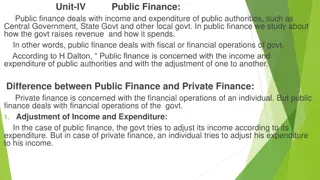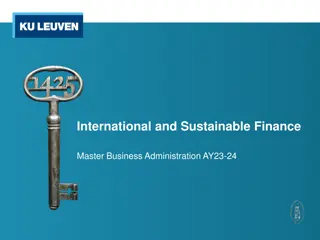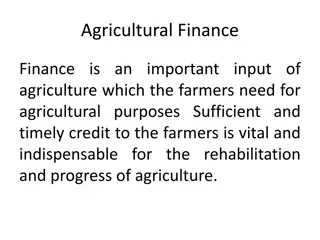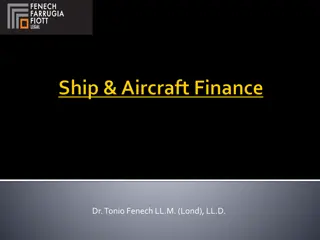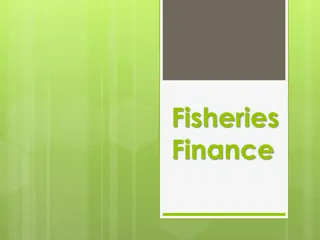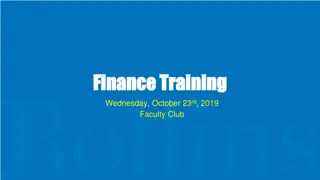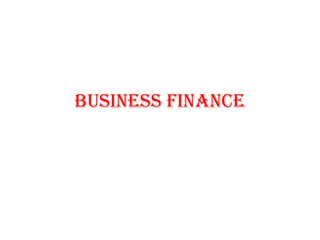
Business Finance: Internal and External Sources
Explore the various internal and external sources of finance for businesses, including retained profit, net current assets, loans, crowd-funding, and more. Learn about the advantages and disadvantages of each source to make informed financial decisions.
Download Presentation

Please find below an Image/Link to download the presentation.
The content on the website is provided AS IS for your information and personal use only. It may not be sold, licensed, or shared on other websites without obtaining consent from the author. If you encounter any issues during the download, it is possible that the publisher has removed the file from their server.
You are allowed to download the files provided on this website for personal or commercial use, subject to the condition that they are used lawfully. All files are the property of their respective owners.
The content on the website is provided AS IS for your information and personal use only. It may not be sold, licensed, or shared on other websites without obtaining consent from the author.
E N D
Presentation Transcript
D1 SOURCESOF FINANCE How many possible sources of finance can you list for a business? Try to think of both internal and external sources. SOURCES OF FINANCE
SOURCESOF FINANCE In this topic you will learn about Advantages, disadvantages, short term and long term: Internal : Retained profit Net current assets Sale of assets External: Owner s capital Loans Crowd-funding Mortgages Venture capital Debt factoring Hire purchase Leasing Trade credit Grants Donations Peer to peer lending Invoice discounting
SOURCESOFFINANCE Sources of finance are the options available to a business when seeking to raise funds to support future business actions For a start-up business this might be raising sufficient capital to establish the business For an established business this might be to fund growth or implement a new strategy e.g. relocation Sources of finance can be: Internal i.e. from within the business e.g. retained profit External i.e. from outside of the business e.g. loans
INTERNALFINANCE Internal sources of finance include: Retained profit Net current assets Sale of assets
RETAINEDPROFIT Profit kept within a business from profit for the year to help finance future activities Retained profit can be used as a short term source e.g. to fund day to day activities or accumulated over time and used as a long term source Advantages Avoids interest repayments Disadvantages Only an option if sufficient retained profit exists within the business Does not dilute the business ownership May cause shareholder dissatisfaction if this is at the expense of dividend payments Stagecoach reinvests 80m profit in 470 new buses. Reduces the security blanket of keeping retained profits for unforeseen situations or to take advantage of new opportunities
NETCURRENTASSETS Current assets are items of value owned by a business that will be used and change in value within a year Inventory Trade receivables Cash and cash equivalents Current liabilities are items owed by a business that are to be repaid within a year Trade payables Overdrafts Net current assets = current assets current liabilities Advantages Disadvantages No interest repayments or loss of ownership May lower profitability if lose discounts for early payments
SALEOFASSETS Sale of assets refers to the sale of a long term or fixed assets Fixed assets will stay in the business for more than a year e.g. machinery and vehicles These assets can be sold in order to get an immediate injection of cash in to a business and thereby provide finance The benefits are: No interest charges or repayments May be turning an obsolete asset into finance Immediate lump sum cash injection However: May be expensive in the long run if need to lease the asset back Loss of use of the asset and future value Is only a one off option Is selling assets an effective way of raising finance for Tesco?
INTERNALFINANCE Internal sources of finance include: Retained profit Net current assets Sale of assets In pairs. Explain, with the use of a business example, when each of these sources of finance is appropriate. Try to consider: the business form e.g. sole trader, partnership or Ltd the financial performance of the business the length of trading e.g. start-up or established
EXTERNALFINANCE External finance is capital raised from outside of the business A source of finance is where the finance is coming from i.e. the provider e.g. A method of finance is how the finance is provided e.g. family and friends banks peer-to-peer funding business angels Crowd-funding other businesses loans share capital venture capital overdrafts leasing trade credit grants
OWNERSCAPITAL Owner s capital is how much the owner has invested in the business Owner s capital shows the proportion of the business assets that are owned by the business owner rather than creditors Owner s capital can be from: personal savings e.g. an entrepreneur setting up as a sole trader or partnership share capital when a business sells shares in return for part ownership in the business
OWNERSCAPITAL: PERSONALSAVINGS The benefits are: To what extent should all entrepreneurs invest some of their own savings in a new business venture? Do not have to repay No interest charges Owner(s) maintain control Risking own savings can be motivational Do not have to go through any lengthy application procedures However: May only be limited amounts available Threat to personal finances and family
SHARECAPITAL Finance raised from the sale of shares This is a form of equity capital i.e. the shareholder becomes a part owner of the business Shareholders will be rewarded for their investment by the payment of dividends but may also benefit from an increase in share price increasing the value of their shares Only an option for incorporated businesses i.e. Ltds and Plcs Issuing shares is a complex and costly process so only really an option for raising large amounts of finance to fund long term projects
SHARECAPITAL Advantages Only need to pay dividends if a profit is being made and the amount of dividend is not fixed Disadvantages Loss of ownership as shareholders are part owners Why has Sony s share prices fallen following an announcement to issue more shares? Potential risk of loss of control for a Plc with a threat of hostile takeovers Possible to raise large amounts of finance No interest repayments Complex and costly process of issuing shares, especially for a Plc
LOANS A set amount of money provided for a specific purpose, to be repaid with interest, over a set period of time May be secured against an asset and if there is a default on repayments the asset can be taken Financial institutions can vary interest rates depending upon the amount of risk placed on the loan An external source of finance generally considered to be more suitable for longer-term projects However this will depend upon the size of the loan and the repayment period
LOANS Advantages Quick and easy to secure Disadvantages Interest must be paid regardless of financial performance Fixed interest rates allow firms to budget A firm that is highly geared may be seen as high risk Improved cash flow A firm normally provides security known as collateral The borrower retains ownership of the company Often more expensive than other forms of finance Can be charged a penalty for early payment
CROWD-FUNDING Crowd-funding involves raising finance from a large number of people each investing different, often small, amounts of money The business uses the internet to explain how much money is required, how it will be used and the exit strategy stating predicted return on the investment The investor is only tied into their promised contribution if the total amount is raised How does crowd-funding work?
MORTGAGES Reread your notes on mortgages as a type of personal borrowing In pairs Write a definition Produce a table of advantages and disadvantages Justify whether it is a short or long term source of finance
VENTURECAPITAL Investment from an established business into another business in return for a percentage equity in the business Also known as private equity finance Venture capitalists will normally look for a high rate of return in a specific time period Why might a Bitcoin start-up opt to use venture capital as a source of finance? The business or entrepreneur may also benefit from expertise and mentoring from the venture capitalist Often associated with high risk start-ups
VENTURECAPITAL Advantages Potential for large sums of money for investment Disadvantages A long and complex process Expert financial projections are likely to be required Expertise to help the business Makes it easier to attract other sources of finance Initially expensive for the firm e.g. legal and accounting fees Provides the required capital for expansion Partial loss of ownership Risk of conflict or perceived interference
DEBTFACTORING The process of selling the debts owed to a business to a financial institution The business will receive funds immediately but at a reduced rate e.g. may only receive 80% of the total value of the debt After the debt has been paid the business will receive further payment but the financial institution will keep a percentage of the repayment as a fee An external source of finance
DEBTFACTORING Advantages Receives a large amount of the debt immediately Disadvantages Reduces profitability of the firm as a result of the fee paid to the financial institution Good source of short-term finance to address cash flow problems Check your understanding of factoring. May damage the reputation of the firm as they are seen to be in need of short-term finance Debts are chased by experts saving managers time Reduces the risk of bad debts
HIREPURCHASE Allows a business to enjoy the use of an asset whilst paying for it in regular instalments The asset remains the property of the seller up until the point where all instalments have been made at which point it becomes the property of the buyer Avoids one off lump sum payments Interest will normally be charged on top of the cost of the asset
LEASING Leasing allows a business to benefit from the use of an asset without owning it or buying it outright The business pays a set amount in instalments to lease the asset for a pre determined period of time The asset remains the property of the leasing company and at the end of the time period the asset is returned to the lease company and the business stops making the payments Avoids the need to finance the asset but may be more costly in the long run However the lease company is responsible for any repairs and maintenance At the end of the lease period the business may start a new lease agreement for the latest model e.g. new spec photocopier!
TRADECREDIT Trade credit is paying suppliers a period of time after the goods or services have been received In effect the supplier is providing the business with finance for the period of the trade credit e.g. 30 days The business may lose out on discounts offered for immediate or quick payment increasing costs
GRANTS Grants are fixed amounts of capital provided to business by the government or other organisations to fund specific projects Often conditions are attached to the grants for example: What grants are available for small businesses in the UK? Locate in an area of high deprivation Provide employment Reduce negative environmental impacts Support a good cause
DONATIONS Finance provided by an individual or organisation to support the activities of another organisation Normally only available to non-profit organisations such as charities and social enterprises Relies on the generosity of others May be severely cut at times of economic difficulties Have to ensure the cost of recieving the donations does not outweigh the amount received in donations!
PEERTOPEERLENDING Peer-to-peer lending (P2P) The practise of an individual lending to other individuals (peers) with whom there is no relationship or contact Borrowers are given a credit rating Normally an unsecured personal loan although on some occasions collateral may be offered Visit Zopa.com to find out more about P2P lending. Cuts out the use of traditional intermediaries e.g. banks Lending is done online Lenders decide who they want to lend to then compete to win the lending opportunity in a reverse auction i.e. the lender willing to offer the lowest interest rate wins The lenders motive is profit
INVOICEDISCOUNTING Business may be able to negotiate a discount on invoices from suppliers This in affect reduces costs, hence freeing up finance for other purposes This may be achieved as a result of early payment or bulk buying Although finance is received helping cash flow in the short term this may have a negative effect on profitability inn the longer term
FINANCE In pairs produce a spider diagram of all the possible reasons why a business will need finance Use high lighter to colour code them between short term and long term needs In each case state an appropriates source Pay wages Buy machinery Finance
ACTIVITY In pairs draw a table 17 rows by and 5 columns Row 1 headers Source of finance, advantages, disadvantages, short term or long term, justification of short term or long term Column 1 use the specification of the last slide to list all the sources of finance Use your notes and further research to complete the table
SOURCESOF FINANCE In this topic you have learnt about Advantages, disadvantages, short term and long term: Internal : Retained profit Net current assets Sale of assets External: Owner s capital Loans Crowd-funding Mortgages Venture capital Debt factoring Hire purchase Leasing Trade credit Grants Donations Peer to peer lending Invoice discounting





